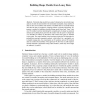Free Online Productivity Tools
i2Speak
i2Symbol
i2OCR
iTex2Img
iWeb2Print
iWeb2Shot
i2Type
iPdf2Split
iPdf2Merge
i2Bopomofo
i2Arabic
i2Style
i2Image
i2PDF
iLatex2Rtf
Sci2ools
MICCAI
2009
Springer
2009
Springer
Building Shape Models from Lousy Data
Statistical shape models have gained widespread use in medical image analysis. In order for such models to be statistically meaningful, a large number of data sets have to be included. The number of available data sets is usually limited and often the data is corrupted by imaging artifacts or missing information. We propose a method for building a statistical shape model from such "lousy" data sets. The method works by identifying the corrupted parts of a shape as statistical outliers and excluding these parts from the model. Only the parts of a shape that were identified as outliers are discarded, while all the intact parts are included in the model. The model building is then performed using the EM algorithm for probabilistic principal component analysis, which allows for a principled way to handle missing data. Our experiments on 2D synthetic and real 3D medical data sets confirm the feasibility of the approach. We show that it yields superior models compared to approaches...
| Added | 06 Nov 2009 |
| Updated | 15 Nov 2009 |
| Type | Conference |
| Year | 2009 |
| Where | MICCAI |
| Authors | Marcel Lüthi, Thomas Albrecht, Thomas Vetter |
Comments (0)

